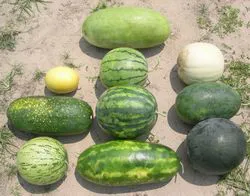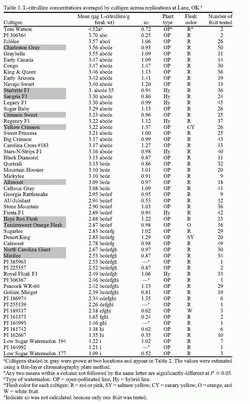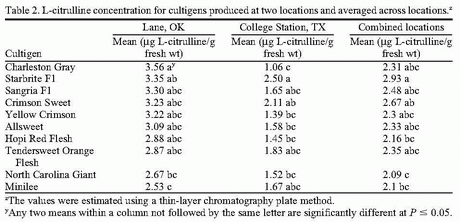 Watermelon (Citrullus lanatus) is the second vegetable, after tomato, in the world for cultivated surface and total production. In the last years, watermelon has been identified as a healthy food for its high content in lycopene and other antioxidant compounds.
Watermelon (Citrullus lanatus) is the second vegetable, after tomato, in the world for cultivated surface and total production. In the last years, watermelon has been identified as a healthy food for its high content in lycopene and other antioxidant compounds. The amino acid L-citrulline helps to regulate the blood pressure and can serve as a source of arginine. The watermelon is rich in citrulline and the content can vary according to the cultivar and the growing environment.
In 2011 a study on the effect of environment and genotype on L-citrulline accumulation in watermelon was published on International journal HortScience. The study was conducted on 56 cultigens (Table 1) cultivated in Lane (Oklahoma, USA), of which 10 (Table 2) were cultivated also in College Station (Texas, USA) to evaluate the environmental effect on L-citrulline accumulation.
 Click here to enlarge Table 1
Click here to enlarge Table 1Cultigen screening showed that the growing environment significantly influenced the L-citrulline content in the fruit.
The plants grown in Lane produced fruit with higher L-citrulline content compared to the fruit harvested from the plants grown in College Station (3.10 µg/g FW vs. 1.67 µg/g FW).
Also among the cultivars, the L-citrulline content significantly varied from 1.09 a 4.52 µg/g FW: ‘Tom Watson’, ‘PI306364’ and ‘Jubilee’ resulted the cultigens with greater tendency to accumulate citrulline.
These three lines could be used to develop improved high-L-citrulline cultivars.
No correlation was found between the L-citrulline concentration and watermelon type (open-pollinated or F1 hybrid) or flesh color (red, orange, salmon, yellow, or white).
Click here to enlarge Table 2.

Source: Davis A.R., Webber III C.L., Fish W.W., Wehner T.C., King S., Perkins-Veazie P., "L-Citrulline Levels in Watermelon Cultigens Tested in two Environments", HortScience, December 2011, 46(12):1572-1575. http://hortsci.ashspublications.org/content/46/12/1572.full.pdf+html
